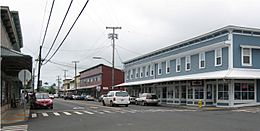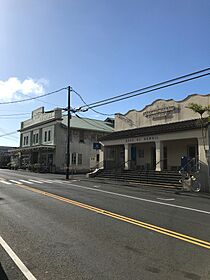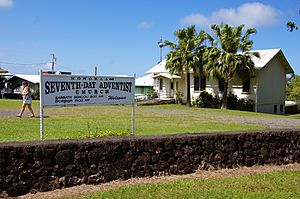Honokaa, Hawaii facts for kids
Quick facts for kids
Honokaa, Hawaii
Honokaʻa
|
|
|---|---|
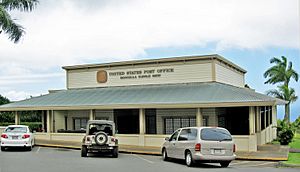
Post office for ZIP code 96727
|
|
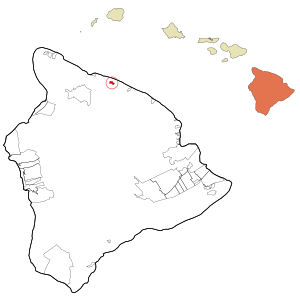
Location in Hawaii County and the state of Hawaii
|
|
| Country | United States |
| State | Hawaii |
| County | Hawaii |
| District | Hamakua |
| Area | |
| • Total | 2.11 sq mi (5.45 km2) |
| • Land | 2.11 sq mi (5.45 km2) |
| • Water | 0.00 sq mi (0.00 km2) |
| Elevation | 994 ft (303 m) |
| Population
(2020)
|
|
| • Total | 2,699 |
| • Density | 1,281.58/sq mi (494.80/km2) |
| Time zone | UTC-10 (Hawaii-Aleutian) |
| ZIP code |
96727
|
| Area code(s) | 808 |
| FIPS code | 15-16450 |
| GNIS feature ID | 0359281 |
Honokaʻa is a small community in the Hamakua District of Hawaiʻi County, Hawaiʻi, United States. It is known as a census-designated place (CDP), which means it's a specific area defined by the census for collecting population data. In 2020, about 2,699 people lived here.
Contents
Geography of Honokaʻa
Honokaʻa is located on the northern side of the Big Island of Hawaiʻi. You can find it at these coordinates: 20°4′39″N 155°27′51″W.
Roads and Travel
Hawaii Route 19 goes through the southern part of the town. This road leads southeast about 42 miles to Hilo. It also goes west about 14 miles to Waimea. Hawaiʻi Route 240 branches off Route 19. It runs through the center of Honokaʻa. This route then continues west for about 8 miles. It ends at the lookout for the beautiful Waipiʻo Valley.
Area Size
According to the United States Census Bureau, Honokaʻa covers a total area of about 2.11 square miles (5.45 square kilometers). All of this area is land, with no water.
Population Changes in Honokaʻa
The number of people living in Honokaʻa has changed over the years. Here's how the population has grown:
- 2000: 2,233 people
- 2010: 2,258 people
- 2020: 2,699 people
This information comes from the U.S. Decennial Census.
History of Honokaʻa's Economy
For many years, Honokaʻa's main business was making sugar. The Hāmākua Sugar Company operated from 1873 to 1994. When the sugar company closed, the local economy faced challenges. It has since become a place where many people live but work in nearby Hilo.
Gateway to the Hāmākua Coast
Honokaʻa is known as the "gateway" to the Hāmākua Coast. When you travel downhill from Waimea, Honokaʻa offers the first clear view of the Pacific Ocean.
New Crops and Farming
The Hāmākua Coast used to be famous for its sugar plantations. After the sugar industry ended, the area had to find new ways to make money. Today, much of the land is still used for farming. Farmers are now growing different crops. These include pineapples, coffee, papaya, macadamia nuts, and tea.
Famous People from Honokaʻa
Honokaʻa has been home to some important people.
Governor John D. Waiheʻe III
John D. Waiheʻe III was the fourth governor of Hawaii after it became a state. He served from 1986 to 1994. He was the first Native Hawaiian to become a governor in the United States.
Other Notable Residents
- Yoshito Takamine was a Hawaiʻi state representative and a leader for workers' rights.
- Roseanne Barr, a well-known American actress, comedian, and writer, also lives in Honokaʻa.
Culture and Community Life
Honokaʻa has a historic downtown area that is full of character.
The People's Theatre
In 1930, the Tanimoto family built the Honokaʻa People's Theatre on Māmane Street. This theater hosted the Hāmākua Music Festival every fall for many years. The money raised from the festival helped fund music education on the island. Many famous musicians have performed there, including jazz artists and Hawaiian folk musicians.
Farming and Ranching
Ranching is a very important industry in Honokaʻa and the Hamakua District. There is also a growing interest in different types of farming. Honokaʻa has a Saturday farmers' market on Māmane Street. There is also The Farmers' Market at Hāmākua Harvest on Sundays. This market sells local products like Hawaiʻi Big Island Beef, which is grass-fed beef raised locally.
Western Weekend Celebration
Ranching in Hawaii has a long and interesting history. To celebrate this tradition, Honokaʻa hosts an annual event called Western Weekend. It started in 2006. The event includes fun activities for kids, country western music, a block party with a paniolo (Hawaiian cowboy) barbecue, and a rodeo.
Honokaʻa in Movies
Honokaʻa has been featured in films.
Honokaʻa Boy
The town is the setting and namesake for a 2009 Japanese film called Honokaʻa Boy. The movie's first showing in the world happened at the Honokaʻa People's Theatre. The theater was a big part of the film.
Cloud Atlas
The town's marketplace is also mentioned in the movie Cloud Atlas.
Schools in Honokaʻa
The community is home to Honokaʻa High & Intermediate School. Honokaʻa Elementary School shares some of the same facilities, like the cafeteria and library.
See also
 In Spanish: Honokaa para niños
In Spanish: Honokaa para niños


